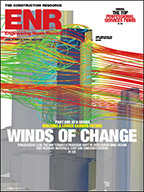New York University has reduced its plan to expand in Greenwich Village by 19%, or 337,000 sq ft, of the proposed 2 million sq ft under the university’s 30-year plan. Manhattan Borough President Scott Stringer approved the changed plan April 11.

Greenwich Village residents and Community Board No. 2 had opposed the plan since its inception in 2007, fearing that the expansion would take away from neighborhood esthetics. So the university changed the plan to ensure that the public-strips surrounding Washington Square Village are preserved by eliminating a proposed 183,000-sq-ft below-grade space and a 20,7000 gymnasium. The revamped plan also eliminates proposed dormitories on the Bleeker Building, and agrees not to develop on the Mercer Plaza strip above NYU’s Cogeneration Plant and maintain it as open space. NYU is also committed to provide space for a 100,000-sq-ft K-8 public school.
"We think the agreement announced today by the Borough President with NYU is an important initial step that addresses major concerns identified by the community board, but there is more work to be done," says Brad Hoylman, chair of Community Board No. 2. "The Borough President is to be commended because it represents the first time NYU has committed to any changes to its massive expansion plan."
At today’s conference, Stringer said that the proposed campus expansion plan “promises to grow the institutional, cultural and educational economy” and will create about 18,200 construction jobs and 9,500 permanent jobs over the next 20 years.
“The agreement we have reached, which comes after five years of deep involvement with the borough president and committed efforts by him, will enable NYU to meet the long-term academic space of its faculty and students while being sensitive to the concerns of our surrounding community,” said John Saxton, president of NYU.
NYU is the third university expansion proposal that Stringer has negotiated through the Uniform Land Use Review Procedure, following in the wake of Columbia University’s 2007 proposed plan and Fordham’s University’s 2009 plan.
The plan must still receive the support of the City Planning Commission and the City Council.
"We still think the plan is too big and threatens to overwhelm the historic neighborhood, so we'll fight to seek additional changes in the ULURP process at the City Council," Hoylman says.


